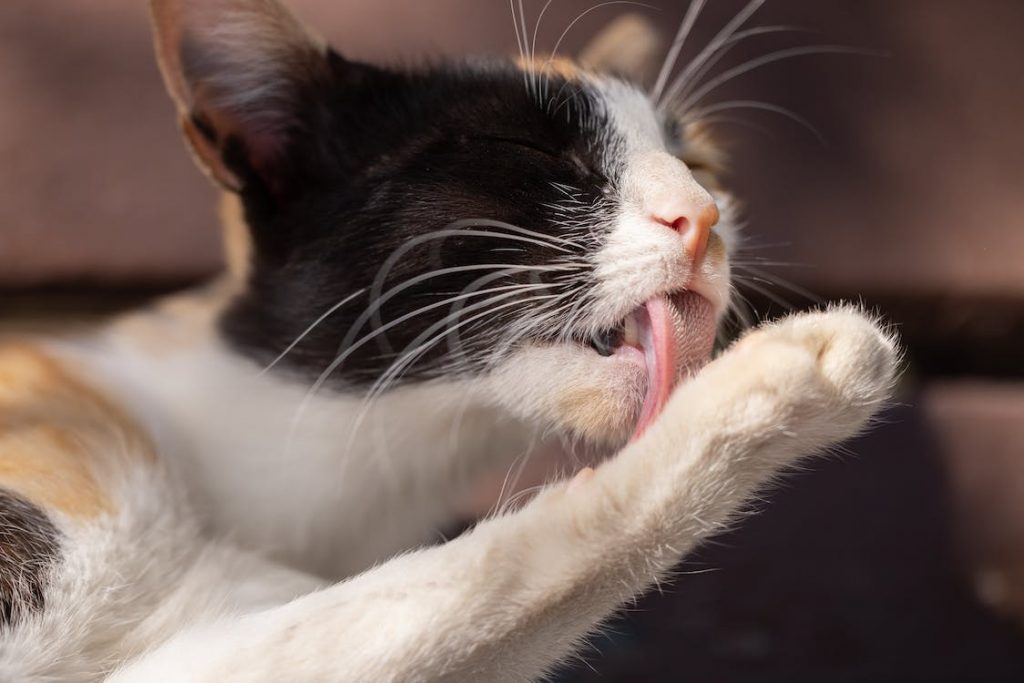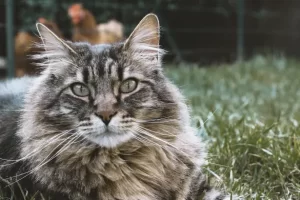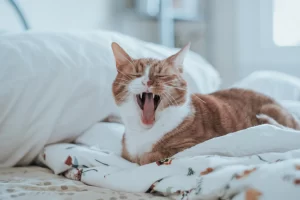Last updated on February 18th, 2023 at 07:23 pm

Is your cat doing the same thing over and over again without any reason at all? Perhaps they keep biting their claws or grooming themselves every time you see them. Do you suspect your cat has OCD but are not sure if OCD is also possible in cats? Let’s answer that question first, OCD exists in cats as well, and it’s not a psychological problem that exists in people only.
OCD, or Obsessive Compulsive Disorder in cats, shows the same symptoms as people with OCD. The only problem is that most fur parents self-diagnose their cats with OCD without consulting a veterinarian. If you are seeing repetitive behaviors from your cat, talk to a vet to diagnose it properly, as it may be a symptom of other cat illnesses such as Alopecia. Don’t worry; we are here to guide you in learning what OCD is in cats, along with a few tips on taking good care of them. Let’s dive in.
What is Obsessive Compulsive Disorder (OCD) in Cats?
Obsessive-Compulsive Disorder (OCD) is a behavioral disorder that is often seen in cats. Typically characterized by excessive grooming, OCD can also affect cats’ eating or sleeping habits, or cause them to obsessively perform certain behaviors, such as chasing their tails or circling the same spot in a room. It is important to recognize the signs of OCD in cats, as it can lead to more serious health issues if left untreated. The exact cause of OCD in cats is unknown, but it is believed to be related to a combination of genetic and environmental factors. Stressful situations, such as changes in the home, a new pet, or a new owner, can trigger OCD-like behaviors in cats. In some cases, medical conditions, such as hyperthyroidism, may also be to blame.
Obsessive Compulsive Disorders in cats are rare, but a few fur parents sometimes self-diagnose their cats with OCD when they see some repetitive behavior. Sure, OCD is doing the same thing excessively without any valid reason. But, not because they do it repeatedly doesn’t mean they have OCD. A few factors can contribute to this behavior, not just psychological.
Let’s take grooming as an example. Cats love to groom, but they are not usually doing it excessively. If they do, it might be a symptom of OCD, but it can also indicate Psychogenic Alopecia, Fleas, or even skin disorders. You can find the root cause first and talk to a vet so your vet can properly diagnose as well as possible treatments.
How Will I Know If My Cat Has OCD?
As mentioned earlier in this article, cats with OCD will exhibit behaviors that seem to be repetitive or obsessive, it can be a single behavior, but some show various and different behaviors. Remember, the common mistake of fur parents is that they don’t consult a vet to diagnose their cat and assume that they have OCD because they are doing things obsessively. Some actions have deeper root cause other than cats being obsessed with them.
The best thing you can do is to as a vet for a diagnosis. For example, cats may sometimes chew or bite their tail and foot. It’s normal behavior because cats usually want to release the itch from a specific body part. However, if the behavior is now causing harm, like tails having wounds and bleeding, it might be a cause of a deeper problem. It might be OCD, but it can also be flea and tick bites. If everything is ruled out except for the fact that they are just obsessed with hurting themselves, then OCD can be the only diagnosis.
Here are some of the most common behavior that cats with OCD exhibit. Take note of these symptoms, as this may indicate OCD in cats.
- Excessive Grooming: According to Debra Horwitz, DVM, this might be the most common symptom of OCD. It may be Alopecia, or your cat may have a lot of fleas. This excessive grooming or Alopecia may produce a few bald spots in your cat’s fur, leading to severe infection or wounds. As we said, cats are natural groomers and love cleaning themselves. But cats with OCD will definitely take cleaning to the next level. If your cat is grooming excessively that it causes harm, consult your vet immediately.
- Repetitive Pacing: Cats with OCD will often pace around the same area of their environment over and over again, often in a circular pattern. This behavior is often done in an attempt to reduce stress or anxiety.
- Too Much Vocalizations: Cats are not as loud and talkative as dogs. That’s why a few fur parents are having a bit of worrying when they hear their cat meowing a lot. There are many reasons behind too much meowing or vocalization, but the usual root cause is stress. Like Pacing and Grooming, it can indicate a more severe problem, perhaps stress, or maybe your cat is in pain.
- Obsessive Fixation on Objects: Cats with OCD will often fixate on an object and obsess over it. This can include items such as toys, food dishes, or even their own tail. They will often carry the object around with them, obsessively playing with it or carrying it around the house.
- Obsessive Sucking: Cats are unpredictable, and they love many things that sometimes confuse us. If you observe that your cat is obsessively sucking or chewing their blankets or other clothes, it can be a sign of OCD.
If your cat has confirmed OCD, it can also exhibit other repetitive behaviors besides those on this list. Always pay more profound attention to your cat and figure out the frequency of these actions. Having a record of the frequency of these behaviors can help your vet diagnose OCD.
Researchers are still figuring out if there’s a reason why cats suddenly develop OCD. But as of now, the main reason is stress. Like in people, stress can affect your cat’s mental state and possibly do some obsessive things to cope.
How do Vets Diagnose Cats with OCD?
Vets diagnose cats with Obsessive Compulsive Disorder (OCD) by observing the animal’s behavior and evaluating its environment. First, the veterinarian will take a detailed history of the cat’s behaviors and any changes that have occurred in its environment. This is important because environmental changes can be a factor in the development of OCD in cats.
The vet will also look for any underlying medical conditions that may be causing the cat’s behavior. The vet will then perform a physical examination to rule out any medical conditions and to identify any potential sources of distress or anxiety. This includes checking for any physical abnormalities and abnormalities in the cat’s external environment. If the vet identifies any potential sources of anxiety or distress, they can be addressed and removed to help manage the cat’s behavior. To further evaluate the cat’s behavior, the vet may use a variety of diagnostic tools. These include behavioral questionnaires, interviews with the owner, and observational tests. According to Dr. Kariuki, the vet may also choose to use a urine or blood test to check for any medical conditions that may be influencing the cat’s behavior. Once the vet has gathered all the necessary information, they can then make a diagnosis.
How to Treat OCD in Cats?
Like Psychogenic Alopecia, there’s no cure for OCD other than modifying and controlling it. If your cat is diagnosed with OCD, your vet may prescribe a few anti-depressant medicines and some environmental changes to reduce the stress that usually triggers OCD in cats. They will advise you on how to modify your cats’ surroundings to help them destress.
As we mentioned a lot in this article, stress and anxiety may be the best trigger for OCD. This is why vets usually recommend medicines for anxiety and stress to control your cat’s OCD behavior. Aside from environmental modification, your vet may also prescribe calming medications such as L-Theanine and a few vitamins to help your cat.
Developing a behavior modification plan can also help reduce the intensity and frequency of the OCD behaviors. This may include providing your cat with a steady routine, establishing a safe and comfortable environment, and offering consistent positive reinforcement for appropriate behaviors. A veterinarian or behaviorist can provide advice on the best approach for your cat.
Do not worry, as your vet knows what he/she is doing. But, to further help them, you should constantly update them about your cat’s progress or if the plan they created is working. Treating or controlling OCD is a long process; you can be the best factor in making it a successful treatment. Be with your cat and give them the best care they need while they are fixing their mindset.
How To Care For Cats With OCD?
Like any other mental condition, cats with OCD will need your help managing it. As we said, you are the most important factor in this treatment. Your vet will take care of all the medication your cat needs, and you will be responsible for making those medications work. Since stress is the most common factor and trigger of OCD in cats, learning how to help your cat cope with it might be the best solution. Here are some tips you can do to help your cat with OCD:
- Reduce your cat’s stress by playing with them and doing other things that your cat will enjoy.
- Do some stress-reducing massage for your cat. After all, who doesn’t like to be pampered?
- Change the things that are causing anxiety and stress. Please do not do the opposite of what your cat likes to do to avoid stressing them. For example, if your cat loves to sleep in a warm bed with a dim light, then do it.
- Do not create any drastic change that can disrupt your cat’s routine.
- Feed them nutritious food to keep their body and mind healthy.
- Give them enough litter boxes around the house.
- Use a few interactive toys to keep them entertained all the time.
- Spend quality time with your cat and make them feel that they are not alone.
- If you have kids, ensure they won’t carry the cat every time. Cats are not usually comfortable when someone is holding them violently, as usual kids do.
As you can see, all you can do is ensure that your cat gets the proper treatment they deserve. To do this, you must learn your cat’s behavior and see what they like and don’t like. Knowing more about your cat is the most important process, as this will dictate what you need to do. Remember, stop creating a stressful environment for your cat. It would be best if you stopped doing things that cause them to panic. Remember, your vet should constantly be updated regarding your cat’s situation. If these environmental and social changes didn’t work and your cat still has those OCD episodes, consult your vet immediately.
Conclusion
Cats are amazing creatures of habit, but they are not obsessed with making these habits frequently unless they have OCD. Living with a cat with OCD will take much time and patience. You have to be there to observe most of the time, especially if their behavior is starting to cause harmful effects on you and your cat. The most important thing to remember is that the cat’s behavior is not intentional, and it is important to provide a safe and stress-free environment in order to help reduce the intensity and frequency of these behaviors. Don’t worry; we are sure that you can pull this off!
Having a pet is a big responsibility, and as a fur parent, you have to keep them physically and mentally healthy. It is therefore, important to provide the cat with a safe and secure environment. Cats with OCD tend to feel anxious and stressed, so it is important to provide them with a calm and stress-free environment. We hope this article answers what OCD is and what you can do to help your cat. Remember, stress is the number 1 culprit in making your cat healthy and happy. Avoid it at all costs by providing the pampering that your pet needs.


